Takealong Containers
Product Review: Trudeau’s FUEL Collection
By Micah Cheek
In the spirit of avoiding a sad desk lunch, I packed a lunch using some items from the FUEL Collection, a lunch carrier set from Trudeau.
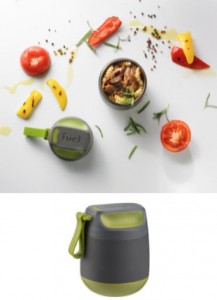 I prepared a red pepper salad for lunch, along with pecans and chips, the most fragile snack I could think of. The red pepper salad went in the egg-shaped Stainless Steel Food Jar, which proved to be very leak resistant and kept my salad cold. The rounded edges make it attention grabbing, especially at a desk during lunch. The steel interior made cleanup easy. Additionally, the bare metal you see when you open the bowl matches nicely with the set’s color scheme. The Stainless Steel Food Jar has a suggested retail price of $24.99.
I prepared a red pepper salad for lunch, along with pecans and chips, the most fragile snack I could think of. The red pepper salad went in the egg-shaped Stainless Steel Food Jar, which proved to be very leak resistant and kept my salad cold. The rounded edges make it attention grabbing, especially at a desk during lunch. The steel interior made cleanup easy. Additionally, the bare metal you see when you open the bowl matches nicely with the set’s color scheme. The Stainless Steel Food Jar has a suggested retail price of $24.99.
My chips went into an included Snack Pocket made of the same material as the main lunch bag. The Pockets have a suggested retail price of $12.99 for a two pocket set. The bag looks flat, but against all odds, my chips remained intact.
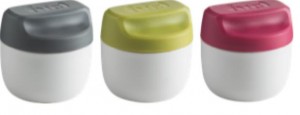 The Condiment Set features little condiment jars made to look like miniatures of the Stainless Steel Food Jar. I used one to hold vinaigrette for my salad. It performed admirably, not letting any oil seep into my lunch bag during transit. While it holds runny liquids like vinaigrette well, the Condiment Set is also sized to hold a sandwich-perfect portion of mustard or mayonnaise. You wouldn’t guess just by looking, but the FUEL Collection cutlery fits perfectly into the condiment jars, making products like jam and hummus an easy option. The Condiment Set comes in sets of three jars, and has a suggested retail price of $5.99.
The Condiment Set features little condiment jars made to look like miniatures of the Stainless Steel Food Jar. I used one to hold vinaigrette for my salad. It performed admirably, not letting any oil seep into my lunch bag during transit. While it holds runny liquids like vinaigrette well, the Condiment Set is also sized to hold a sandwich-perfect portion of mustard or mayonnaise. You wouldn’t guess just by looking, but the FUEL Collection cutlery fits perfectly into the condiment jars, making products like jam and hummus an easy option. The Condiment Set comes in sets of three jars, and has a suggested retail price of $5.99.
A water bottle is also available for the collection. It only holds 15 ounces of fluid, but it is sturdily built and easily cleaned. The spout is wide enough that it could be effectively used for smoothies or unfiltered juices. The spout is also in a straw setup, with a flexible tip that won’t hurt your teeth if you bite it. Called the Splash Bottle, this bottle retails for $9.99.
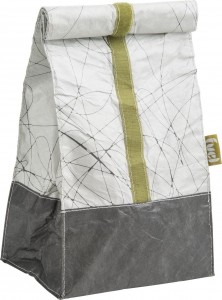 All the separate parts of the collection fit snugly into the Classic Bag, which has a papery plastic outside reminiscent of a brown paper bag, and a thermally insulated plastic layer inside. The bag follows a muted color pattern, centered around sage green, eggshell white and charcoal gray.
All the separate parts of the collection fit snugly into the Classic Bag, which has a papery plastic outside reminiscent of a brown paper bag, and a thermally insulated plastic layer inside. The bag follows a muted color pattern, centered around sage green, eggshell white and charcoal gray.
For someone who frequents the convenience store hot dog bar as often as I do, eating a real meal with color-coordinated containers is a refreshing experience. I think I enjoyed my meal more than I would have if I had packed it in a disposable plastic bag. The only thing I didn’t like about the aesthetic was the Snap Cutlery Set. While it worked perfectly well and was color coordinated, the proportions of the fork and spoon make them look like the entry-level silverware for toddlers. That said, their small size allowed them to fit into the bag efficiently with everything else. The Snap Cutlery Set retails for $5.99.
The use of Velcro strips to hold the Classic Bag and Snack Pocket closed was an interesting move away from the usual zipper sealing closures. My main concern with it was in washing out the bag, with the possibility of water getting trapped in the strip’s fibers. With hand washing, the bags cleaned up easily, and pressing a cloth into the Velcro fibers is effective at drying them out. The bags can be turned inside out, but I found it unnecessary for cleaning up dry snack residue. Unlike more traditional bags, the Classic Bag does not seal horizontally along the top. Two long strips of Velcro are laid out vertically along opposing sides of the bag. To seal, I rolled the top down so that one strip of Velcro comes in contact with the other, closing up just like an old-fashioned brown paper bag. It’s a system I haven’t seen in other lunch containers and is surprisingly effective. Even though most of the bag’s mouth isn’t held together, the rolling action that seals it is surprisingly strong, which allowed me to turn the full bag upside down and shake it without the Velcro coming loose.
Price may be a concern for some consumers. The full retail value of this entire lunch set is about $60, although the pieces are sold separately. However, the set looks composed yet casual, seals very well and is sturdy. All FUEL products are BPA-free as well and include a lifetime warranty. Many are available in Kiwi and Raspberry colors. This set is perfect for the customer who is willing to spend a little extra to have a lunch tote that will impress daily and last a long time or who’s picking and choosing specific containers to meet individual needs rather than splurging on the entire set at once.
Product Review: Not Just for Sack Lunches – U-Konserve To-Go Containers
By Lorrie Baumann
The camping trip I took to Grand Canyon in March didn’t exactly go as planned. Between the trip to the International Home + Housewares Show in Chicago followed immediately by three days in Anaheim, California for Natural Products Expo West and then coming back to the office to send the April issue of Kitchenware News & Housewares Review to print, I didn’t have a whole lot of time for last-minute packing, so when the Saturday morning that started my vacation week came along, I more or less threw my tent and sleeping bag, my campstove and cook pots and my new Lodge dutch oven and a lawn chair into the trunk of my car, and then I packed into my insulated picnic bag a week’s worth of frozen chicken thighs and some foil-wrapped turkey burgers and headed north.
By the time I got to Phoenix, I remembered that although I had the dutch oven, the charcoal and the fire starters and the foil-wrapped food to put in the dutch oven, I’d forgotten my tongs for arranging the coals around the oven. Fortunately, Phoenix has hardware stores, and I found one. Between Phoenix and Flagstaff, I remembered that I was also going to need an oven mitt because the dutch oven was going to be hot coming out of the fire pit.
It wasn’t until I had checked into my campsite at Mather Campground that I reconsidered my ill-advised choice to leave my hard-sided cooler behind once I’d seen how much food actually fit into the insulated picnic bag. Mather Campground is, well, infested is a harsh word, but it fits, so let’s use it. Mather Campground is infested with ravens who seem to enjoy nothing more than vandalizing the campsites of novices who are so foolish as to hang trash bags from the trees or leave their food supply outside in soft picnic coolers. I left my picnic bag in my car for a quick trip to the Canyon Village Market and General Store, where I bought a hard-sided cooler I could leave under my picnic table. And a bag of ice.
After these initial missteps, I had a wonderful week in Grand Canyon National Park, but now everybody I know has seen all the pictures they can stand of the scenery, the elk, the ravens and the squirrels, so I am going back to Grand Canyon later this month to get some new shots. This time, I am going to the North Rim, which is rather less developed than the South Rim, and I am determined to be rather less casual about the preparations.
This is why last weekend I bought four U-Konserve Medium To-Go Containers and two U-Konserve Large To-Go Containers. This time around, I plan once again to apply my preferred strategy of preparing and freezing my dinner choices ahead of time and then loading them into an ice chest to thaw slowly but stay chilled until time to cook them. Last time, I packaged everything up in double layers of aluminum foil, but as I was making those daily walks up to the trash receptacle to keep that foil out of the beaks of the pesky ravens, I was rather appalled at how much of it there was. I wanted a better solution – a way to freeze food and then cook it either over the campstove or in the dutch oven in the same container, but without wasting all that foil.
I want to be able to cook and eat out of the same container because Grand Canyon is, after all, in the midst of a desert, and water must be conserved. Every drop of water used by 5 million visitors to the South Rim each year comes from Roaring Springs, across the Colorado River on the north side of the canyon. It is transported through the Trans-Canyon Pipeline, which travels for 16 miles along the North Rim, across the Colorado River and then up the South Rim. Completed in 1970, the aluminum pipeline is well beyond its 30-year life expectancy, and the estimated cost to replace it is around $150 million. The water is precious, and my share of it will have to be hauled from a communal spigot to my campsite in whatever container I buy to replace the one the ravens pecked the hole in during my March trip. (I’m pretty sure that was just sheer petty revenge because I didn’t leave all that foil lying around for them to shred all over the campsite.) All of those considerations made stainless steel food containers an obvious choice.
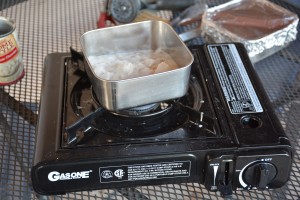 Of the available options, the U-Konserve containers looked like the best sizes for what I had in mind. Sticking to my goal of being better prepared this time, I tested the containers at home in my back yard before committing to taking them to Grand Canyon with me. I had a few questions to answer: Would these containers actually work as pots on my butane camp stove? These containers claim to be leakproof, but are they really? And will the medium container hold enough for a full meal, or will I need to invest in more of the larger size? How will these containers fit into my dutch oven? And finally, are these containers worth the price, because stainless steel is not cheap?
Of the available options, the U-Konserve containers looked like the best sizes for what I had in mind. Sticking to my goal of being better prepared this time, I tested the containers at home in my back yard before committing to taking them to Grand Canyon with me. I had a few questions to answer: Would these containers actually work as pots on my butane camp stove? These containers claim to be leakproof, but are they really? And will the medium container hold enough for a full meal, or will I need to invest in more of the larger size? How will these containers fit into my dutch oven? And finally, are these containers worth the price, because stainless steel is not cheap?
To answer the first three questions, I went the easy route and just opened a can of Campbell’s soup and dumped it into one of the Medium To-Go Containers and sealed it with the plastic lid. The lids are heavy BPA-free plastic that snap down firmly but without particular difficulty and open easily too. I picked up the container and sloshed it around a bit, then held it upside down and shook it a few times, then did it all again. When I set it back down, I could see that the soup seemed to have crept up into the seal on the inside of the container, but none of it had leaked out. I put the soup-filled container into the freezer and froze it solid. When I took it back out of the freezer, the lid needed only a few seconds to warm before it was willing to flex enough to come off the container – or maybe that was my hands were cold from handling the frozen steel – but then it peeled off easily without showing any signs of brittleness. If I should lose a lid somewhere, I can replace it by ordering it directly from U-Konserve through the company’s website.
It was then that it occurred to me that it had been totally unnecessary to freeze the actual soup I was then planning to eat – I could have done the exact same test by freezing a block of water, which I could have made good use of by emptying it out of the container onto my garden, so in the interests of having dinner on the same day, I decided to put that container of soup back in the refrigerator to thaw for another day, and I opened another can of soup and dumped it into another of the containers for the second phase of the experiment, which was the cooking test over the butane camp stove. Here, once again, the container performed flawlessly. About all you can ask for from stainless steel is efficient and even heat conduction, and what you want from a camping pot is that it sits stable on your stove, holds a reasonable amount of food and doesn’t make you feel like too much of a dork when you’re eating from it. All good here.
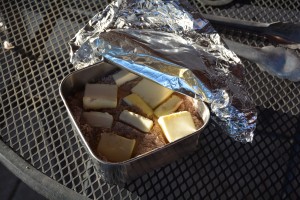 Then for the final phase of the experiment, I lit some charcoal and fetched out the dutch oven for a dump cake trial. This actually took me two tries, with one attempt with the container set directly onto the floor of the dutch oven and then a second attempt with the container set on a rack inside the dutch oven. Both times, I made the dump cake with half a can of apple pie filling, a quarter of a chocolate cake mix and half a stick of butter. On the first attempt, the cake mix on top hadn’t cooked thoroughly before the pie filling on the bottom had caramelized and began sticking to the pan. For the second try on the rack, I baked it an extra five minutes or so, and it came out perfectly. For the record, that’s 40 minutes with 13 coals underneath and nine coals on top of the dutch oven.
Then for the final phase of the experiment, I lit some charcoal and fetched out the dutch oven for a dump cake trial. This actually took me two tries, with one attempt with the container set directly onto the floor of the dutch oven and then a second attempt with the container set on a rack inside the dutch oven. Both times, I made the dump cake with half a can of apple pie filling, a quarter of a chocolate cake mix and half a stick of butter. On the first attempt, the cake mix on top hadn’t cooked thoroughly before the pie filling on the bottom had caramelized and began sticking to the pan. For the second try on the rack, I baked it an extra five minutes or so, and it came out perfectly. For the record, that’s 40 minutes with 13 coals underneath and nine coals on top of the dutch oven.
So, all things considered, my only question now is whether I really have enough of these extremely useful containers. They were easy to label with a Crayola washable marker on the side, and they’re versatile and sturdy enough to justify the price tag. I feel more prepared for Grand Canyon now.
ECOlunchboxes: the Convenience of Plastic Without the Plastic
By Lorrie Baumann
ECOlunchbox introduced its new Blue Water bento box line at this year’s International Home + Housewares Show. The stainless steel containers with silicone lids offer families a plastic-free option that avoids concerns about whether chemicals might be leaching from plastic containers into the food inside them.
Sandra Harris, ECOlunchbox’s Founder and President, started the company seven years ago after she’d become aware of concerns about the presence of bisphenol A (BPA), an industrial chemical used to make polycarbonate, a hard, clear plastic, in food storage containers. After it was shown that small, measurable amounts of the packaging materials may migrate into food and can be consumed with it, the packaging industry responded by abandoning the use of BPA for containers such as baby bottles and sippy cups.
These days, BPA is still in use in some applications where it comes into contact with food, and the federal Food and Drug Administration has decided that BPA is safe at the levels in which it’s currently found in foods that have been exposed to packaging that contains the chemical, but the agency continues to study this issue to resolve remaining uncertainties.
“We thought, better safe than sorry,” Harris says. Her family traded in their plastic water bottles for stainless steel, and Harris went looking for nontoxic, nonplastic food containers for families that just didn’t want to be exposed to the chemical. Her company launched in 2009 with a line of two stainless steel food containers and a backpack-style lunch bag with napkins that she designed and sewed from fair trade block-printed fabric that she sourced in India. She started out selling the containers and lunch bag at a local holiday fair. The products sold well there, so she went to a few other events in the San Francisco Bay area. “Within a few months, Whole Foods Northern California wanted to bring in the product line,” she says. “From there, we’ve gone on to sell over 285,000 ECOlunchboxes worldwide and have averted the disposal of millions of pieces of trash, mostly plastic.”
Today, Harris regards herself as a social entrepreneur who’s driving positive change for health and the environment through selling things. “The more we sell, the more change we make,” she says. Last year she was invited to participate in an event on Capitol Hill, where she shared the impact of the lunch boxes and talked about how the capitalist engine can be part of the solution to pollution. She was recently named the Small Business of the Month for April 2016 from California State Assembly District 16 by Assemblywoman Catharine Baker (R-Dublin), and she has also received other local awards for green business.
Her newest product line, the Blue Water bento line, was launched with a Kickstarter campaign in 2015 and introduced to the housewares industry at this year’s International Home + Housewares Show. “We’re a small business that turned to the community for support, and we got an enthusiastic response from more than 700 Kickstarter backers,” Harris says. “We got the funding to bring the line to market.”
The Blue Water bento line is nontoxic, plastic free containers that fit together as a set. They’re made with stainless steel bottoms and blue leakproof silicone lids patterned with a marine theme. The Splash Box is a rectangular bento box that tucks into a lunch bag along with two small Pods that fit right on top of the Splash Box. At the end of the day, the empty Pods nest inside the Splash Box, and it comes home collapsed together. “It offers the convenience of plastic without any plastic or any of the downside,” Harris says.
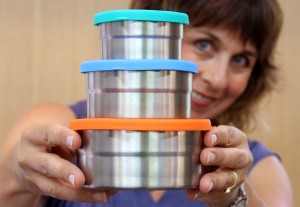 The Seal Cup Trio is another similar lunch set, except that the containers are round rather than rectangular. They’re also made of stainless steel with silicone lids, and the set of three containers will hold a total of five cups of food. “We find that most people like to bring an entree and two snacks or two sides,” Harris says. “Three is just a real popular number when it comes to how people sort their food for lunchtime.”
The Seal Cup Trio is another similar lunch set, except that the containers are round rather than rectangular. They’re also made of stainless steel with silicone lids, and the set of three containers will hold a total of five cups of food. “We find that most people like to bring an entree and two snacks or two sides,” Harris says. “Three is just a real popular number when it comes to how people sort their food for lunchtime.”
ECOlunchbox products are currently sold at Bed Bath & Beyond and The Container Store as well as independent grocers and children’s boutiques nationwide as well as in Europe, Canada and Asia.
New Everyday Essentials from Aladdin
Aladdin, a brand of PMI, introduces new everyday essentials for 2016 in its hot beverage, cold beverage and food storage collections that build off the brand’s mission established over 107 years ago – to create products that fold seamlessly into consumers’ everyday life, at home and on-the-go. While Aladdin’s offerings have changed a bit since 1908, the brand continues to bring affordable design and quality performance to products that help consumers ‘Make the Most of Everyday.’ Designed to make otherwise ordinary eating and drinking moments more fun, Aladdin’s newest products are both reusable and easy to use. From a hinged infusion basket that provides an all-in-one steeping and sipping experience, to the intuitive Flip-Seal™ 100 percent leak-proof flip lid, Aladdin upgrades the user experience with smart style and functionality; creating everyday essentials that become instant favorites.
“Aladdin’s quality, performance and striking design come from years of putting the consumer at the heart of our business. We are thrilled to bring this level of consumer product innovation to the market this year,” said Rich DePencier, Vice President of Aladdin.
Aladdin’s 2016 collection features sleek style, stress-free portability and intuitive functionality, from leak-proof lids to dishwasher safe containers. Highlights from the 2016 collection include:
Thermal Beverageware, Cold
Glass-Lined Water Bottle (18-ounce): Aladdin’s new Glass-Lined Water Bottle is made for the person who prefers to drink out of glass, but is worried about taking it on-the-go. It is encased in lightweight and durable Eastman Tritan™ plastic for peace of mind. In addition, it features a leak-proof push button flip lid, an easy to grab carry loop and it fully disassembles for cleaning in the dishwasher. Dishwasher safe, BPA-free. Suggested retail price is $17.99.
Insulated Stainless Steel To-Go Tumbler (16-ounce): Classic café style meets modern material with Aladdin’s Insulated Stainless Steel To-Go Tumbler. Aladdin has taken a long standing favorite (the Insulated Plastic To-Go Tumbler) and updated it with a new material. The iconic To-Go Tumbler features the same double-wall insulation and smoothie straw, but it’s been updated with stainless steel and new colors. Dishwasher safe, BPA-free. Suggested retail price is $17.99.
Thermal Beverageware, Hot
Topo Stainless Steel Mug (16-ounce): Add a dash of style to your morning coffee. Building on the success of Aladdin’s intuitive and easy to use Flip-Seal™ leak-proof lid, The Topo Mug adds a new silhouette. It features a raised geometric pattern that is designed to feel good in your hands while providing superior functionality. Perfect for caffeinating on-the-go, the leak-proof lid keeps bags dry and drinks warm, plus mug and lid are dishwasher safe for easy cleanup. Dishwasher safe, BPA-free. Suggested retail price is $17.99.
Custom Tea Infuser (12-ounce): Take your tea ritual on-the-go. Aladdin’s new Custom Tea Infuser is an all-in-one solution for steeping and enjoying tea on-the-go. It features a hinged infusion basket (for easy filling and cleaning) that lowers and lifts via a silicone tab that secures in the lid – lower to steep, lift and secure when tea has reached desired strength. The microwave safe body is double wall insulated and made of lightweight Eastman Tritan™ that won’t crack, break or stain. Dishwasher safe, BPA-free. Suggested retail price is $19.99.
Food Storage Solutions
Insulated Easy-Keep Lid Food Containers (16-ounce, 24-ounce): For families on the go, Aladdin’s Insulated Easy-Keep Lid Food Container’s foam insulated lid and body makes transporting hot and cold food a breeze. Designed to fully disassemble for easy cleaning, the leak-proof lid keeps food in place with snap-in hinge, plus the containers stacks neatly in backpacks and cabinets. Microwave and dishwasher safe, BPA-free. Suggested retail prices are $12.99 and $14.49.
Innovative New Products from Takeya
Building on its 55 years of food and beverage storage innovation, Takeya® USA introduces two new innovative product lines at the International Home and Housewares Show.
Visit Takeya at booth #S3643.
Takeya USA introduces Takeya Freshlok™, its new line of dry food storage. Takeya’s new collection features a 100 percent airtight seal for a superior barrier that extends freshness. Designed to store common foods and ingredients, such as breakfast cereals, grains, nuts and seeds, tea and coffee, spices, pasta, rice, beans, crackers, pretzels, potato chips and more, Takeya Freshlok encourages individuals and families to avoid the all too common and wasteful practice of throwing out food that’s gone stale in the pantry.
“Developing innovative products that make it easier to enjoy daily routines, such as preparing and storing food, in a way that’s good for one’s health, wallet and the environment, is part of our company’s DNA,” says John Lown, Founder and Chief Executive Officer of Takeya USA. “Takeya Freshlok is expertly designed to keep air and moisture from spoiling the texture, flavor and fresh aroma of a variety of dry foods, while also hitting high marks for convenience, ease of use and affordability.”
Made of a high grade, BPA-free material that’s highly durable and shatterproof, the Takeya Freshlok container is also significantly lighter than other food storage products for easier lifting and carrying. Takeya Freshlok’s transparent body and see-through lid make it quick and easy to identify what’s inside, no matter how or where it’s placed, including on its side, in cabinets or in kitchen drawers.
Expanding its array of meticulously crafted, eco-friendly drinkware for hydration on the go, Takeya USA debuts Thermoflask™, a new collection of powder coated, stainless steel beverage bottles with double-wall vacuum insulation. It is available in five colors – Steel (silver), Snow (white), Asphalt (black), Orchid (purple) and Ocean (blue) and offered in five capacity sizes – 14-ounce, 18-ounce, 24-ounce, 32-ounce and 40-ounce
Sporting a double-wall vacuum insulation that prevents condensation from forming on the bottle, and a high quality vacuum seal to prevent temperature outside the flask from affecting the inside, Thermoflask keeps water, juice, iced tea, iced coffee, wine, cocktails and other beverages cold for up to 24 hours. Thermoflask’s durable, food-grade stainless steel construction won’t absorb flavors, prevents rusting and is built to last under the most active, challenging or adventurous occasions.
Ideal for breaking free from the reliance of wasteful and costly disposable water bottles, Thermoflask is a BPA-free, reusable solution backed with a limited lifetime warranty. Topping its sleek profile is a locking twist cap that completely locks into place for a leak proof seal. The drinking spout is carefully designed to ensure ideal beverage flow, and the flask’s wide mouth provides ample room to fill with ice. Moreover, the uniquely designed lid, which has a tactile band for easy gripping, is universally sized to fit on any Thermoflask size. Thermoflask also comes equipped with a convenient, solid loop handle for easy carrying and hanging.
For more information, call 714.374.9900 x316 or email sales@takeyausa.com.

You must be logged in to post a comment.